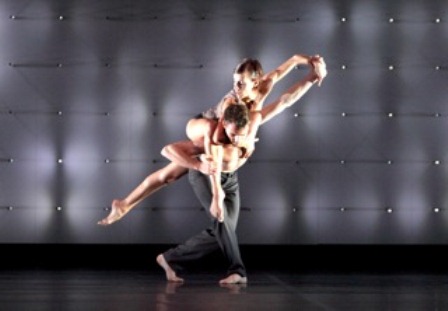11 October 2012, Northern Stage, Newcastle-upon-Tyne
Wayne McGregor’s works are always accompanied by intellectually demanding notes and explanations. FAR is no exception. Made originally in 2010, it is according to McGregor inspired by a study of the Enlightenment by English academic Roy Porter entitled Flesh in the Age of Reason (from which comes, as an acronym, the name of McGregor’s work).
However, I am a fan of the now probably outmoded concept of ‘intentional fallacy’ whereby the artist’s intention is not a standard for judging the success or failure of a work. While it is always interesting to read what the artist believes is the intention of, or forms the inspiration for a work, the work has to stand on its own and must be open to the necessarily varied interpretations of the audience.
FAR begins with a duet, which can only be described as a passionate, if somewhat acrobatic, exploration of the boundaries of what the body can do in dance. The couple, a man and a woman, are attended by four black-clad figures holding flaming torches. These figures vanish quietly and almost imperceptibly one by one throughout the duet. The dancers perform to an 18th century aria, Sposa son disprezzata (‘I am wife and I am scorned’) by Gemininao Giacomelli and sung by Cecilia Bartoli, and the whole is extraordinarily emotional.
But this lush opening gives way to the hard edge of the 21st century as a growling electronic score by Ben Frost takes over and the flicker of torches is replaced by LED lighting (design by Lucy Carter) in the form of five rows of tiny tubes projecting from a rectangular, white board, which occupies much of the back section of the stage. The choreography too seems to lose its fluidity and becomes more angular, and full of flicking hands and very busy bodies.
Occasionally one might read a narrative line into some sections. There are moments when the dancers seem to engage in an argument for example as they push each other around. Occasionally too the ensemble of ten dancers moves as one and this comes as something of a shock to the eye after the seemingly random structuring of bodies on stage. A duet for two men is a highlight, as is a brief moment when two dancers crouch low together on the stage holding a difficult pose on half pointe.
The work closes with another strong duet for a man and a woman in which the woman’s body in particular is often stretched taut, as if to balance the rippling bodies that we have seen in abundance throughout the work. In the final moments the man lowers the woman to the floor, leaves her lying there and walks off.
Some may have seen in this work a connection between body and soul, which was at the heart of Porter’s investigations into the 18th century mode of thinking and behaving. I didn’t think about it as I watched the show. More than anything, seeing McGregor’s tangled yet clearly articulated choreographic moves is a treat, especially when performed by the athletic dancers who make up Random Dance. It was a pleasure to see Anthony Whitely again too, now dancing with Random Dance after his stint with Sydney Dance Company.

Michelle Potter, 14 October 2012